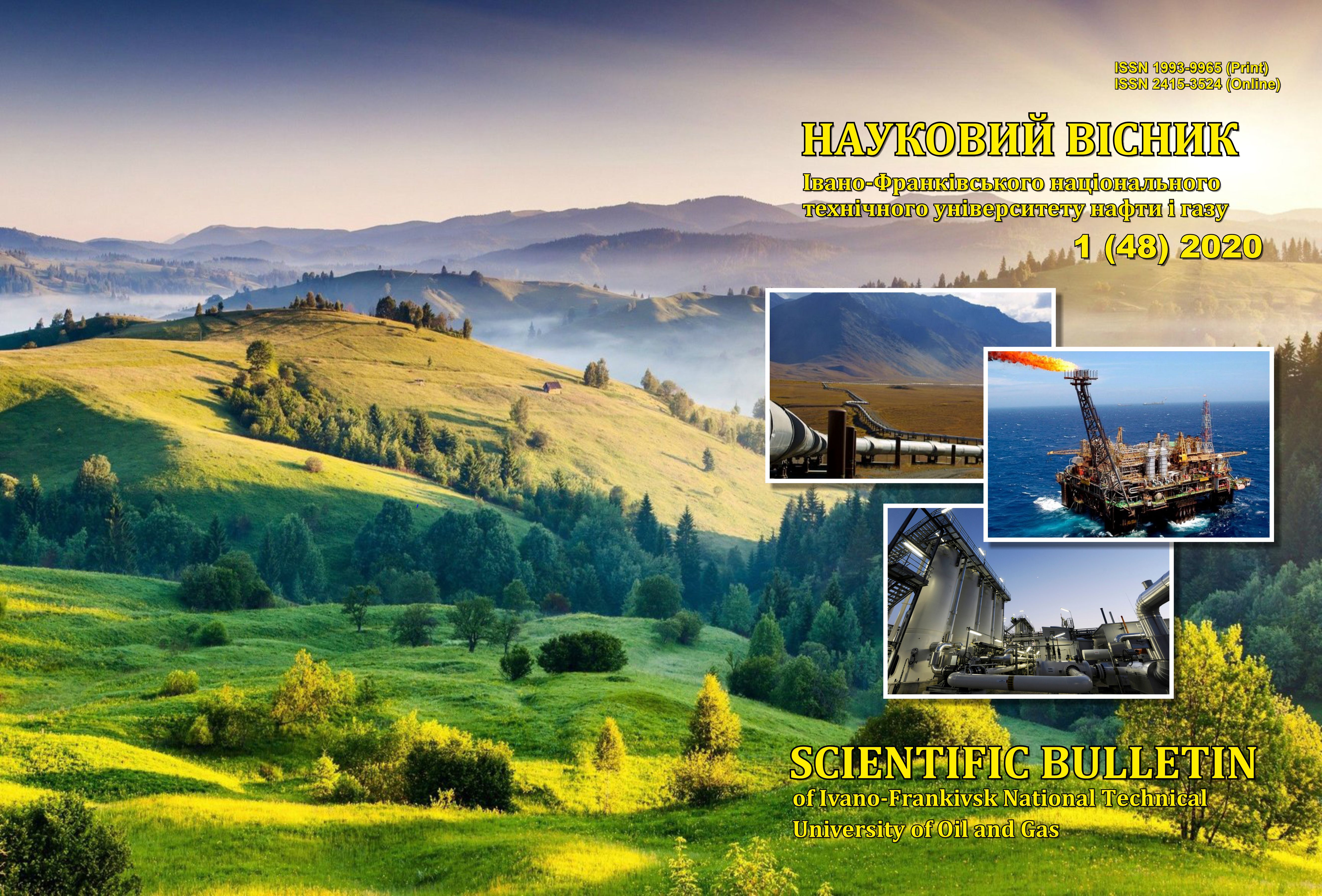Construction of a generalized hardening curve for isotropic plastic metal materials
DOI:
https://doi.org/10.31471/1993-9965-2020-1(48)-38-46Keywords:
generalized deformation curve, strengthening area, yield criterion, the hypothesis of the existence of a generalized curve, scatterplot diagram of experimental data, correlationAbstract
One of the main ways to increase reliability and at the same time reduce the materials consumption of pipes under pressure, used in the oil and gas transportation system, is to improve theoretical and computational meth-ods to predict critical loads in their walls. These studies are based on the problem of accuracy and reliability of calculations at the stage of determination of mechanical characteristics of structural materials. Prediction of ul-timate stresses and strains in the material is performed by approximation of experimental data using deformation curves or yield strenghth. The purpose of the work is to propose a universal way to obtain a generalized curve for better consistence with the experimental data for each specific material. The paper describes a method used to develop a one-parameter model of a generalized deformation curve for plastic metal materials. To obtain the parameter p value as a constant of the material, it is necessary to have the results of several simple biaxial tension experiments with various combinations of the principal stress ratios. For the most accurate calculation of constant material p, it is required to minimize the effect of errors at preparation, testing and result processing stages. The model verifi-cation for other materials and selection of additional quality indicators will allow satisfactory accuracy to describe the generalized deformation curve and predict the stress-strain state of the material. In combination with the methods for structural geometry, the obtained generalized curve can be used to predict the real stress values in pipe walls under pressure.
Downloads
References
Semenov A. A. Analysis of the strength of shell structures, made from modern materials, according to various strength criteria. Diagnos-tics, Resource and Mechanics of materials and structures. 2018. Iss. 1. P. 16 – 33. URL: https://doi.org/10.17804/2410-9908.2018.1.016-033
Law M, Bowie G, Fletcher L, Piper J. Burst pressure and failure strain in pipeline. Journal of Pipeline Integrity. 2004. P. 95–113. URL: https://www.researchgate.net/publication/ 283925162_Burst_pressure_and_failure_strain_in_pipeline
Zhang Sh., Wang Q., Zho, W. Implemen-tation of the Tresca yield criterion in finite element analysis of burst capacity of pipelines. International Journal of Pressure Vessels and Piping. 2019. Vol. 172, P. 180-187. URL: https://doi.org/10.1016/j.ijpvp.2019.03.037
Bony, M., Alamilla, J. L., Vai, R., Flores, E. Failure pressure in corroded pipelines based on equivalent solutions for undamaged pipe. ASME. J. Pressure Vessel Technol. 2010; 132(5): 051001. URL: https://doi.org/10.1115/1.4001801
Zhu, Xian-Kui, Leis, Brian N. Prediction and Comparison of Burst Pressure for Line Pipes. Proceedings of the 2010 8th Internation-al Pipeline Conference. 2010 8th International Pipeline Conference, Volume 1. Calgary, Alberta, Canada. September 27 – October 1, 2010. P. 873-880. ASME. URL: https://doi.org/10.1115/IPC2010-31581
Xian-Kui Zhu, Brian N. Leis, Average shear stress yield criterion and its application to plastic collapse analysis of pipelines, International Journal of Pressure Vessels and Piping, 2006, Volume 83, Iss. 9, P. 663-671. URL: https://doi.org/10.1016/j.ijpvp.2006.06.001. (http://www.sciencedirect.com/science/article/pii/S0308016106001281)
Hui-Er X. A linearized and unified yield criterion of metals and its application. Appl Math Mech, 1994. Iss. 15, P. 485–489. URL: https://doi.org/10.1007/BF02451498
Billington E.W. Generalized isotropic yield criterion for incompressible materials. Ac-ta Mechanica. 1988. Iss. 72, P. 1–20. URL: https://doi.org/10.1007/BF01176540
Emmens W.C., Van Den Boogaard A.H. A Yield Criterion Based on Mean Shear Stress. Key Engineering Materials. 2014. P. 611 – 612. URL: https://doi.org/10.4028/www.scientific.net/ kem.611-612.3
Pisarenko G. S., Lebedev A. A. Deformi-rovanie i prochnost materialov pri slozhnom napryazhennom sostoyanii. Kiev: Nauk. dumka, 1976 [in Russian].
Lebedev A.A., Kovalchuk B.I., Giginyak F.F., Lamashevskiy V.P. Mehanicheskie svoystva konstruktsionnyih materialov pri slozhnom napryazhennom sostoyanii / Pod red. akademika NAN Ukrainyi A.A.Lebedeva. Kiev: Izdatelskiy dom “In Yure”, 2003. 540 p. [in Russian].
Drucker D.C. and Prager W. Soil mechanics and plastic analysis for limit design. Quart. Appl. Math. 1952. 10, No 2. P. 157–165
Yagn Yu.I. Novyie metodyi rascheta na prochnost. Vestnik inzhenerov i tehnikov, 1931, Vol. 6. P. 122–127. [in Russian]
Raschet na prochnost detaley mashin: Spravochnik / I. A. Birger, B. F. Shorr, G. B. Iosilevich. 4-e izd., pererab. i dop. M.: Mashinostroenie, 1993. 640 p. [in Russian]
Potapova L. B., Yartsev V. P. Statisticheskiy kriteriy tekuchesti tverdyih materialov pri slozhnom napryazhennom sostoyanii. Vestnik TGTU. 2003. No3. [in Russian]. URL: https://cyberleninka.ru/article/n/ statisticheskiy-kriteriy-tekuchesti-tverdyh-materialov-pri-slozhnom-napryazhennom-sostoyanii
Oreshko E.I., Erasov V.S., Grinevich D.V., Shershak P.V. Obzor kriteriev prochnosti materialov. Trudyi VIAM. 2019. No 9 (81). [in Russian] URL: http://viam-works.ru/ru/articles?art_id=1467
YU, M.H., Advances in strength theories for materials under complex stress state in the 20th Century. Appl. Mech. Rev. 2002. 55, 3, P. 169–218. URL: https://doi.org/10.1115/1.1472455
Mehanicheskoe povedenie materialov pri razlichnyih vidah nagruzheniya / V.T.Troschenko, A.A.Lebedev, V.A.Strizhalo i dr. K.: Logos, 2000. 570 p.
Shkodzinsky O., Kozbur G., Kostyshyn S. (2005) Metodyka uzahalnennia diahramy deformuvannia izotropnykh materialiv dlia skladnoho napruzhenoho stanu [The technique of generalizing the diagram of isotropic material deformation in case of complex stressed state]. Scientific Journal of TSTU (Tern.), vol. 10, no 1, PP. 25-30. [in Ukrainian]. URL: http://elartu.tntu.edu.ua/handle/lib/31408
Hosford, W. F. A Generalized Isotropic Yield Criterion. ASME. J. Appl. Mech. June 1972; Т. 39(2). P. 607–609. URL: https://doi.org/10.1115/1.3422732
Kaminskiy A.A., Bastun V.N. Deforma-tsionnoe uprochnenie i razrushenie metallov pri peremennyih protsessah nagruzheniya. K.: Nauk.dumka, 1985. 168 p. [in Russian]
Downloads
Published
How to Cite
Issue
Section
License
Авторські права....


1.png)

















